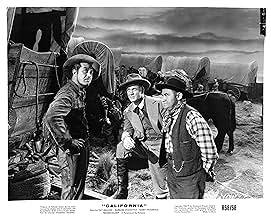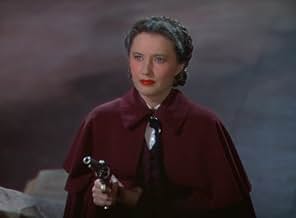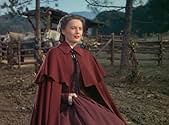VALUTAZIONE IMDb
6,1/10
1212
LA TUA VALUTAZIONE
Aggiungi una trama nella tua linguaEpic account of how California became a state, featuring a wagon train, the Gold Rush, a wicked saloon queen, and an evil profiteer.Epic account of how California became a state, featuring a wagon train, the Gold Rush, a wicked saloon queen, and an evil profiteer.Epic account of how California became a state, featuring a wagon train, the Gold Rush, a wicked saloon queen, and an evil profiteer.
- Regia
- Sceneggiatura
- Star
John Alban
- Delegate
- (non citato nei titoli originali)
George Anderson
- Miner
- (non citato nei titoli originali)
Carl Andre
- Wagon Train Member
- (non citato nei titoli originali)
Billy Andrews
- Boy
- (non citato nei titoli originali)
Recensioni in evidenza
The movie is a stab at an epic western that simply fails to gel. The best part is the "moving west" scenes of wagon trains convoying across the open southwestern terrain. These achieve an epic feel that the dramatics unfortunately fail to duplicate. The screenplay itself is pretty crowded, telling the story of California's becoming a state, no less. From settlers to gold rush to saloons to political intrigue, the story is traced out mainly through Milland, Stanwyck, and Coulouris, with Fitzgerald as a salt-of-the-earth anchor.
Now, that might work, except director Farrow has little feel for the material. The various parts come across in rather limp, unexciting fashion. It's as if he's content to simply film the script without bringing its many conflicts to dramatic life. Thus, the drama is conveyed in words instead of characters. Then too, Oscar winner Milland appears either miscast or uninspired. His role really calls for a bigger personality than Milland's generally low-key wagon master. (He may have viewed a western as a comedown after his award winning role in The Lost Weekend.) Stanwyck is of course Stanwyck even though she's dolled-up to suit Technicolor filming and crowded around by the packed screenplay . Too bad the guy who could have enlivened the action remains in supporting background, namely, the commanding Albert Dekker (Pike).
Anyway, I guess I now know why this epic western remains so obscure, despite its Paramount pedigree and marquee cast.
Now, that might work, except director Farrow has little feel for the material. The various parts come across in rather limp, unexciting fashion. It's as if he's content to simply film the script without bringing its many conflicts to dramatic life. Thus, the drama is conveyed in words instead of characters. Then too, Oscar winner Milland appears either miscast or uninspired. His role really calls for a bigger personality than Milland's generally low-key wagon master. (He may have viewed a western as a comedown after his award winning role in The Lost Weekend.) Stanwyck is of course Stanwyck even though she's dolled-up to suit Technicolor filming and crowded around by the packed screenplay . Too bad the guy who could have enlivened the action remains in supporting background, namely, the commanding Albert Dekker (Pike).
Anyway, I guess I now know why this epic western remains so obscure, despite its Paramount pedigree and marquee cast.
If back in 1946 when California the movie was made, let alone in the 1840s when California came to the USA via the Mexican Cession, people knew what a sprawling entity California would become, the idea of a separate California country that George Coulouris wanted to have might have been the idea might have been sold. As it is now California has about 9% of the House of Representatives and a population and budget bigger than most countries.
But we're back in the year of 1849 when trail guide Ray Milland is guiding a wagon train to the Pacific, to the newly acquired lands of the Mexican War. He's reluctantly allowed Barbara Stanwyck to travel with Barry Fitzgerald on the train. Stanwyck's been given a heave-ho out of town similar to what Claire Trevor got in Stagecoach. The two of them are mighty attracted to each other, but Milland thinks she's cheap and Stanwyck thinks he's stuck up.
It tears it for Milland when Stanwyck upon reaching California takes up with George Coulouris, a powerful, rich, and mysterious former sea captain who gained his fortune in the slave trade. He's a mean one to cross and his ambitions include nothing less than carving out a separate California Empire with himself as head.
So the political mixes with the personal as Milland fights Coulouris for California and Stanwyck.
California was a big budget item for Paramount that year, the only thing it lacked was Cecil B. DeMille directing it. The film was shot on location in Sedona, Arizona in gorgeous technicolor, courtesy of Ray Rennahan. You have to remember that Milland had won the Best Actor Oscar for The Lost Weekend the previous year and Paramount was now trying to take advantage of that.
Stanwyck loved making westerns and it sure shows here. This was Ray Milland's first starring western, he'd do a few more and not bad ones either. Fitzgerald steals the show of course in every scene he's in as the wise grape grower who sees vineyards in the Napa Valley as part of California's future.
The whole thing is nicely directed by John Farrow. And of course Coulouris will creep you out with his brand of villainy. Catch it when it's broadcast.
But we're back in the year of 1849 when trail guide Ray Milland is guiding a wagon train to the Pacific, to the newly acquired lands of the Mexican War. He's reluctantly allowed Barbara Stanwyck to travel with Barry Fitzgerald on the train. Stanwyck's been given a heave-ho out of town similar to what Claire Trevor got in Stagecoach. The two of them are mighty attracted to each other, but Milland thinks she's cheap and Stanwyck thinks he's stuck up.
It tears it for Milland when Stanwyck upon reaching California takes up with George Coulouris, a powerful, rich, and mysterious former sea captain who gained his fortune in the slave trade. He's a mean one to cross and his ambitions include nothing less than carving out a separate California Empire with himself as head.
So the political mixes with the personal as Milland fights Coulouris for California and Stanwyck.
California was a big budget item for Paramount that year, the only thing it lacked was Cecil B. DeMille directing it. The film was shot on location in Sedona, Arizona in gorgeous technicolor, courtesy of Ray Rennahan. You have to remember that Milland had won the Best Actor Oscar for The Lost Weekend the previous year and Paramount was now trying to take advantage of that.
Stanwyck loved making westerns and it sure shows here. This was Ray Milland's first starring western, he'd do a few more and not bad ones either. Fitzgerald steals the show of course in every scene he's in as the wise grape grower who sees vineyards in the Napa Valley as part of California's future.
The whole thing is nicely directed by John Farrow. And of course Coulouris will creep you out with his brand of villainy. Catch it when it's broadcast.
I always thought Barbara Stanwyck had the measure of any of the men she co-starred with in westerns, and here she certainly holds her own as the manipulative "Lily". She joins a wagon train heading west, but the gold rush rumours split that up and so she proceeds to the coast where she quickly ends up owning quite a lucrative saloon. She's pretty much sharing control of the town with the odious storekeeper/daylight robbery merchant "Pharaoh Coffin" (George Colouris) when her erstwhile pals "Trumbo" (Ray Milland) and "Fabian" (Barry Fitzgerald) arrive, all amidst increasing calls for Californian statehood. Needless to say, those in power locally want the status quo - the new arrivals want something more "democratic". What now ensues are a series of cat-fights that keep this moving along well enough until, what I must admit to feeling was a bit of a disappointing denouement. Stanwyck stands out, and Fitzgerald and the rather oddly cast Coulouris are also effective. Milland, however, well he doesn't quite cut the mustard and there is way, way too much dialogue as this story takes far too long to get up any head of steam. Still, it's got a pioneering sort of spirit to it that I quite enjoyed.
Definitely NOT a great movie, but very enjoyable, especially if one is a Stanwyck fan. Cinematography bounced back and forth from lush, to "quick, get it done" shots.
Ray Milland did not quite cut it as the hardened trail boss and buffalo hunter. But maybe that's because his character really is not-he deserted from the army for getting involved with a married woman. Stanwyck shines as the self-reliant lady gambler and flirt who has been tossed around her whole life, with a few exceptions.
Yes the movie is rather corny, but let's face it the movie industry was right in the middle of the Macarthy era and needed safe material to work with. It DID give a rather honest perspective of how many lost sight of what they really had set out for, and how others took advantage, at any cost.
Ray Milland did not quite cut it as the hardened trail boss and buffalo hunter. But maybe that's because his character really is not-he deserted from the army for getting involved with a married woman. Stanwyck shines as the self-reliant lady gambler and flirt who has been tossed around her whole life, with a few exceptions.
Yes the movie is rather corny, but let's face it the movie industry was right in the middle of the Macarthy era and needed safe material to work with. It DID give a rather honest perspective of how many lost sight of what they really had set out for, and how others took advantage, at any cost.
In this movie John Farrow shows the great director he was. The camera work is exceptional, with scenes lasting more than 4 minutes filmed in just one take!. Although there are several of this scenes in the movie, there are other aspects to comment also. The actor's direction is superb, obtaining the most of all of them, in particular the performance of George Colouris (the villain) is outstanding. Moreover, this is not the typical western; the plot shifts unexpectedly from the line one assumes it will follow, to a very different one, and the movie maintains its coherence perfectly. A real gem.
Lo sapevi?
- QuizThis film was in production November 1945-February 1946, and bears a 1946 copyright statement, and was released in January 1947.
- BlooperA number of the pistols used by characters appear to be cartridge revolvers, rather than cap-and-ball.
- Citazioni
Lily Bishop: You may think you're pretty high and mighty, Trumbo. But let me tell you this... if I live long enough, and I will, I'm going to pull you down off that fancy horse of yours and shove your face in the muck - so help me!
- ConnessioniFeatured in Qualcosa di cui... sparlare (1995)
I più visti
Accedi per valutare e creare un elenco di titoli salvati per ottenere consigli personalizzati
- How long is California?Powered by Alexa
Dettagli
- Tempo di esecuzione1 ora 37 minuti
- Colore
- Proporzioni
- 1.37 : 1
Contribuisci a questa pagina
Suggerisci una modifica o aggiungi i contenuti mancanti

Divario superiore
By what name was Vecchia California (1947) officially released in India in English?
Rispondi


































